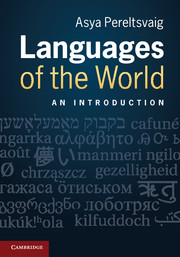Book contents
- Frontmatter
- Contents
- Figures
- Maps
- Tables
- Words, words, words…
- Acknowledgements
- Abbreviations used in the glosses
- 1 Introduction
- 2 Indo-European languages
- 3 Non-Indo-European languages of Europe and India
- 4 Languages of the Caucasus
- 5 Languages of Northern Africa, Middle East and Central Asia
- 6 Languages of sub-Saharan Africa
- 7 Languages of eastern Asia
- 8 Languages of the South Sea Islands
- 9 Aboriginal languages of Australia and Papua New Guinea
- 10 Native languages of the Americas
- 11 Macro families
- 12 Pidgins, creoles and other mixed languages
- Glossary
- References
- Index of languages
- Index of terms
8 - Languages of the South Sea Islands
- Frontmatter
- Contents
- Figures
- Maps
- Tables
- Words, words, words…
- Acknowledgements
- Abbreviations used in the glosses
- 1 Introduction
- 2 Indo-European languages
- 3 Non-Indo-European languages of Europe and India
- 4 Languages of the Caucasus
- 5 Languages of Northern Africa, Middle East and Central Asia
- 6 Languages of sub-Saharan Africa
- 7 Languages of eastern Asia
- 8 Languages of the South Sea Islands
- 9 Aboriginal languages of Australia and Papua New Guinea
- 10 Native languages of the Americas
- 11 Macro families
- 12 Pidgins, creoles and other mixed languages
- Glossary
- References
- Index of languages
- Index of terms
Summary
In the previous chapter, we talked about languages of eastern Asia; but there is one family spoken in the far southeast of Asia and in Oceania that we have not touched on so far. This family – the Austronesian family – is the subject of this chapter. Although most geographic definitions of Oceania include Australia and Papua New Guinea but not Indonesia, in accordance with our principle of dividing the world into geo-linguistic rather than purely geographical zones, we will defer the discussion of languages spoken in Australia and Papua New Guinea till the next chapter, while languages of Indonesia will be discussed here. A more precise definition of the Austronesian realm is given in the following section.
The existence of the Austronesian family, although not the full extent of it, was first recognized as early as 1706 when Adriaan (Hadrian) Reland, a Dutch scholar, cartographer and philologist, published a work titled Dissertatio de linguis insularum quarundam orientalum, in which he noted similarities between Philippine languages, Indonesian and Malagasy, as well as Polynesian languages, such as Futuna, based on word lists collected as early as 1616 by Reland's compatriots, explorers Jacob Le Maire and Willem Schouten (on Dutch explorations in the Austronesian realm, see also Chapter 1). But the first researcher to extensively explore Austronesian languages using the comparative method was a German scholar Otto Dempwolff (1871–1938). In the 1920s and 1930s he was able to reconstruct Proto-Austronesian based on the many languages spoken on the islands of Southeast Asia and in the Pacific Ocean. Today, the Austronesian family is on a par with Bantu, Indo-European and Semitic language families as one of the best-established ancient language families.
- Type
- Chapter
- Information
- Languages of the WorldAn Introduction, pp. 143 - 165Publisher: Cambridge University PressPrint publication year: 2012



